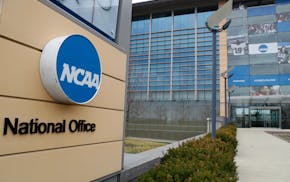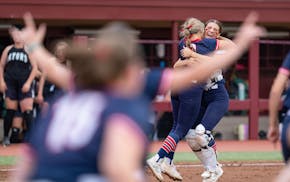They have finally found a home for the purses.
Whether it was a Fendi shoulder sling or a Trader Joe's tote, the thousands of bags that Vikings fans have relinquished at U.S. Bank Stadium security gates during the past two years wound up in a landfill or incinerator.
But in the drive to score what the NFL and stadium officials hope will be the first zero-waste Super Bowl — and launch the first zero-waste football stadium — those fans can now donate their bags to the women's nonprofit Dress for Success.
That's one of the more novel solutions the stadium has adopted in its effort to dramatically increase the amount of gameday trash that is put to good use through recycling or composting.
"There are Coach purses — our women are ecstatic," said Stephanie Silvers, executive director of Dress for Success, which provides financial education and job-hunting support for 1,000 women a year
It's taken awhile to get to this point, stadium and NFL officials acknowledge. A year ago, the stadium was recycling 20 percent of the garbage that left the stadium after every game and event — up to 40 tons in total — mostly food waste and non-recyclable containers. And those purses.
Now "we are well down the path," said Mike Vekich, chairman of the Minnesota Sports Facilities Authority.
But getting there took a lot of work.
In the last year, the food vendors have all switched to compostable containers. The stadium purchased some 375 clearly marked, $1,500 single and triple compartmented bins, which now stand like sentinels along the concourses and in all the suites. Then there are three massive compactors in the bowels of the building to compress each type of waste before it's loaded into waiting trucks.
The stadium management firm, SMG, has hired a sustainability manager, arranged to donate all unopened food from the kitchens to food shelves, and contracted to deliver recyclables and organics to the Hennepin County Recycling and Transfer Station in Brooklyn Park and a composting facility in Rosemount.
"It's an unbelievably large operation," said Paul Kroening, Hennepin County's supervising environmentalist. "It takes a lot to feed 50 or 60 thousand people."
And now, with Super Bowl LII just weeks away, U.S. Bank Stadium is ready for its oh-so-green debut.
12,000 trees
The National Football League has long had environmental goals for each Super Bowl, and they have increased over time, said Jack Groh, director of the league's environmental program — including some that football fans might find surprising. It almost always includes tree planting and other projects to balance the extra carbon emissions produced by the massive event. Last fall, the NFL helped pay to plant 12,000 trees across Minnesota and provided funds for community gardens. It also hosted an electronics recycling event at the Minnesota Zoo that collected 42,000 pounds of waste.
No question, some cities make it easier than others.
San Francisco, for example, "knocked it out of the park" for Super Bowl 50 in 2016, said Lewis Blaustein, a New York sports marketing consultant who writes the GreenSportsBlog. Local officials had everything from ride-share bikes and water bottles to biodiesel buses for what was billed as "The Greenest Super Bowl Ever."
Houston last year — not so much.
"As far as I could tell, they did nothing," Blaustein said.
And the Phoenix Super Bowl in 2015 was zero waste — for one day, said Groh. (Zero waste doesn't mean zero exactly. It means a 90 percent rate of recycling and composting.)
And the host community this year? "Minnesota is incredible," Groh said. "I say that every year, but I actually mean it this year."
It doesn't hurt that the Twin Cities already has a robust recycling and composting system for businesses, partly because the state charges relatively high fees for waste that goes to a landfill or incinerator.
It also has an active and well-organized nonprofit community that's finding ways to re-use and distribute everything from food to banners to carpeting once the game is over, Groh said.
"It's a rough road to find a use for a million square feet of carpet," he said. This year the carpeting used in tents and other temporary venues will be donated to schools and other buildings.
And for all the stadium's first-time visitors on the big Sunday, the NFL will deploy 170 "green ambassadors" to wander the concourses and help them get the hang of the new right-bin-for-the-right-trash discipline.
"We're educating fans," he said. "We've never done anything at this level before."
Flashing beer cups
There are still some quintessentially Super Bowl problems yet to resolve, Groh said. For example: the 65,000 Bud Light non-recyclable plastic cups that will flash with a team's color every time it scores.
"Is that the bomb or not?" Groh said. "From an environmental standpoint, I hate it. But from a spectacular event standpoint it's the coolest thing in the world."
Most fans will take the cups home, he said. For roughly 6,000 that might be left behind, he's still looking for a sponsor to cover the cost of taking them to an e-waste facility for proper dismemberment after the game.
In fact, the NFL hopes that this year's effort will be such a success that from here on out, Super Bowls will tip other stadiums into permanent zero-waste and carbon-balanced facilities. "We are excited about carrying this through in Atlanta," the site for next year's Super Bowl, Groh said.
Still, Blaustein said, there is no question that the NFL and the U.S. Bank Stadium could do better.
For one, he said, there's the problem of migratory birds that may be killing themselves on the west facade's towering glass panels, he said. The MSFA and the Vikings are sharing the cost of a $300,000 study of the issue, with results due in 2019.
And overall, the NFL's efforts fall short compared to other national sports leagues, especially the National Hockey League, he said. Three years ago, the NHL promised what he described as the Stanley Cup game-changer when it pledged to completely offset the CO2 emissions that its 30 teams generate each season, and find ways to reduce them annually.
Most importantly, the NFL doesn't do enough public promotion of what Groh describes as a pretty quiet sustainability effort. Blaustein said he's waiting for the day when NBC commentators Al Michaels and Cris Collinsworth talk about it on the air.
"Unless you tell people about it, what good is it?" he said. "Sports is a powerful platform for social change."
But for now, the purses are taken care of at U.S. Bank Stadium — and maybe other venues in the future. Silver, of Dress For Success, said the NFL has approached her about arranging similar donations at other league events.
"So don't bring a bag to the Super Bowl unless you want to donate it," she said. "And if you want to throw in a $20 bill, that would be fine."
Josephine Marcotty • 612-673-7394

Twins call up pitching prospect Travis Adams to bullpen

Twins open homestand with loss to Blue Jays, Jeffers ejected after critical call

Federal judge approves $2.8B settlement, paving way for US colleges to pay athletes millions

United South Central wins Class 1A softball title with overpowering pitching



